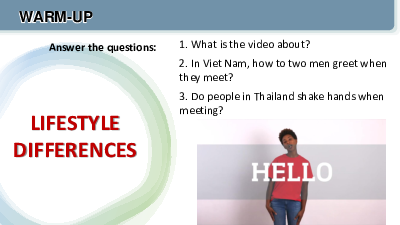Unit 6 LIFESTYLES
LESSON 1: GETTING STARTED Lifestyle differences 1
LESSON 1: GETTING STARTED WARM-UP Asking questions PRESENTATION Vocabulary Task 1: Listen and read.
Task 2: Read the conversation again and complete the table. PRACTICE
Task 3: Complete each sentence with a word or phrase from the box.
Task 4: Label each picture with a word or phrase from the box. FURTHER
Task 5: QUIZZ: Greetings around the world. PRACTICE Wrap-up CONSOLIDATION Homework WARM-UP Answer the questions: 1. What is the video about?
2. In Viet Nam, how to two men greet when they meet?
3. Do people in Thailand shake hands when meeting? LIFESTYLE DIFFERENCES
Document Outline
- Slide 1
- Slide 2
- Slide 3
- Slide 4
- Slide 5
- Slide 6
- Slide 7
- Slide 8
- Slide 9
- Slide 10
- Slide 11
- Slide 12
- Slide 13
- Slide 14
- Slide 15
- Slide 16
- Slide 17
- Slide 18
- Slide 19
- Slide 20











































